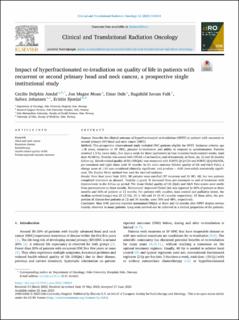| dc.description.abstract | Purpose
Describe the clinical outcome of hyperfractionated re-irradiation (HFRT) in patients with recurrent or second primary (SP) head and neck cancer (HNC).
Methods
This prospective observational study included HNC patients eligible for HFRT. Inclusion criteria: age ≥18 years, recurrent or SP HNC, planned re-irradiation and ability to respond to questionnaires. Patients received 1.5 Gy twice daily, five days a week for three (palliative) or four (curative/local control) weeks, total dose 45/60 Gy. Toxicity was scored with CTCAE v3 at baseline, end of treatment, at three, six, 12 and 36 months follow-up. Health-related quality of life (HRQoL) was measured with EORTC QLQ-C30 and EORTC QLQ-H&N35, pre-treatment and eight times until 36 months. In the main outcome (Global quality of life and H&N Pain), a change score of ≥10 was considered clinically significant, and p-values < 0.05 (two-sided) statistically significant. The Kaplan-Meier method was used for survival analyses.
Results
Over four years from 2015, 58 patients were enrolled (37 recurrent and 21 SP). All, but two patients completed treatment as planned. Toxicity (≥grade 3) increased from pre-treatment to end of treatment with improvement in the follow-up period. The mean Global quality of life (QoL) and H&N Pain scores were stable from pre-treatment to three months. Maintained/ improved Global QoL was reported by 60% of patients at three months and 56% of patients at 12 months. For patients with curative, local control and palliative intent, the median survival (range) was 23 (2–53), 10 (1–66) and 14 (3–41) months respectively. Of those alive, the proportion of disease-free patients at 12 and 36 months, were 58% and 48%, respectively.
Conclusion
Most HNC patients reported maintained HRQoL at three and 12 months after HFRT despite serious toxicity observed in many patients. Long-term survival can be achieved in a limited proportion of the patients. | en_US |

